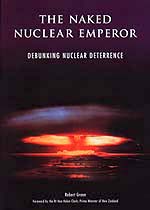The Naked Nuclear Emperor
by Robert Green
INTRODUCTION

In May 1998, a shocked world learned that its biggest democracy, India, had carried out five underground nuclear tests. Pakistan, locked in a deadly struggle with India over Kashmir, responded with its own tests within weeks. On 11 June, The Bulletin of the Atomic Scientists moved its "Doomsday Clock" five minutes closer to midnight. In 1953, it stood at two minutes to midnight, and in 1984, at three: it now stands at nine minutes to midnight.
How could this have happened, nearly ten years after the Cold War ended? The world thought that the nuclear nightmare had faded with the collapse of the Soviet Union and dismantling of the Warsaw Pact. The five declared nuclear weapon states _ the United States (US), Russia, China, the United Kingdom (UK) and France _ had agreed not to target their nuclear forces on each other; and they had stopped underground testing when they signed a Comprehensive Test Ban Treaty. Bilateral negotiations between the US and Russia to reduce their bloated arsenals seemed to be progressing.
An early indication that the nuclear powers' plan to sustain the status quo was in trouble came during the 1990_91 Gulf War, when Iraq was found to be secretly developing nuclear weapons _ with crucial Western help _ despite being a signatory of the Nuclear Non-Proliferation Treaty. The Western nuclear states failed to draw the correct lessons: in November 1991, NATO reaffirmed that nuclear weapons were "essential" to its security, and the Pentagon recommended a new role for nuclear weapons to deter chemical and biological weapon threats from "rogue" states. The US, UK and France went on to pillory Iraq and North Korea for trying to acquire a crude nuclear weapon capability, while continuing to turn a blind eye to Israel's deployed arsenal of over 200 warheads which France and others had secretly helped it to build.
The next scare came in January 1995, when the Russian military detected an unidentified ballistic missile over Norway possibly heading for Russia. For the first time, the Russian "nuclear briefcase" carried by the President was activated. Disaster was averted by only a few minutes when the missile was reassessed as a Norwegian research rocket. This drew attention to the fact that the US and Russia each still had over 2,000 nuclear warheads poised on hair-trigger alert to launch at each other. What is more, when the Year 2000 millennium computer problem emerged, neither side was prepared to stand down their nuclear forces.
Following NATO enlargement eastwards, an increasingly impoverished and militarily weakened Russia announced that it was reviving its dependence on nuclear weapons for its security. In 1996, the Western nuclear states ignored an Advisory Opinion by the World Court that the threat or use of nuclear weapons is generally illegal, and that they were under an obligation to negotiate an enforceable global treaty prohibiting nuclear weapons, like the widely-acclaimed one for chemical weapons. Then NATO intervened in the Balkans without UN Security Council approval, alienating both Russia and China, and ensuring that any more progress on nuclear disarmament would be further delayed. Incredibly, over 30,000 nuclear weapons remain: and as the World Court reminded us, only they have the potential to destroy all civilization and the entire ecosystem of the planet.
Underlying and driving this deepening crisis in nuclear disarmament is an addiction to the doctrine of nuclear deterrence. It has now become clear that the nuclear weapon states, led by the US, UK and France, cite nuclear deterrence doctrine as the final, indispensable justification for maintaining their nuclear arsenals. Nuclear deterrence must therefore be debunked and alternatives offered if there is to be any serious prospect of eliminating nuclear weapons.
Although a vast literature exists on the subject, it is discursive, fragmented and academic. Many powerful arguments are buried deep in inaccessible volumes. To my knowledge, no attempt has been made since the end of the Cold War to draw together, in a concise form, a comprehensive critique of nuclear deterrence doctrine and safer alternative approaches to achieving security. That is why this booklet is needed.
My approach is first to describe why and how, as a former operator of nuclear weapons, I rejected nuclear deterrence. Subsequent chapters tackle the essence of the issue; its history, and arguments supporting my conclusion that nuclear deterrence does not work, and is immoral and illegal. Finally, I offer some alternative security strategies which could lead the world back from the nuclear abyss.
Where possible, information and arguments are referenced, with a selected bibliography for further reading; and arguments are grouped under headings for easy retrieval. My intention is to provide a quick-reference primer for those who must now challenge the naked nuclear emperor.
My hope is that, having read it, an ordinary citizen with little prior knowledge of the issue will be able to understand why nuclear deterrence has no clothes, and there are safer ways to achieve security.
